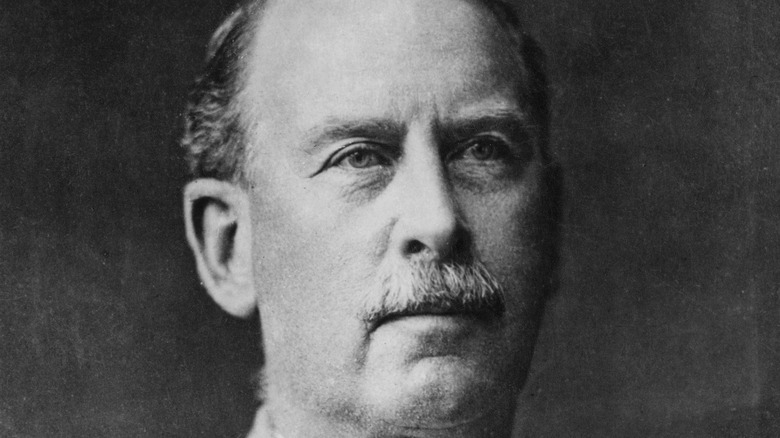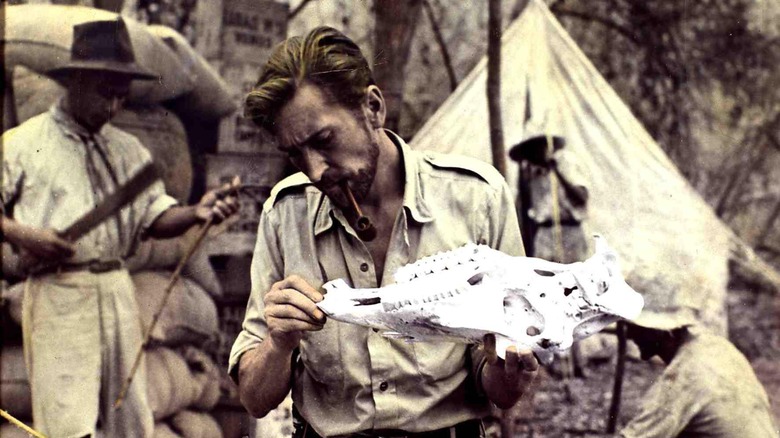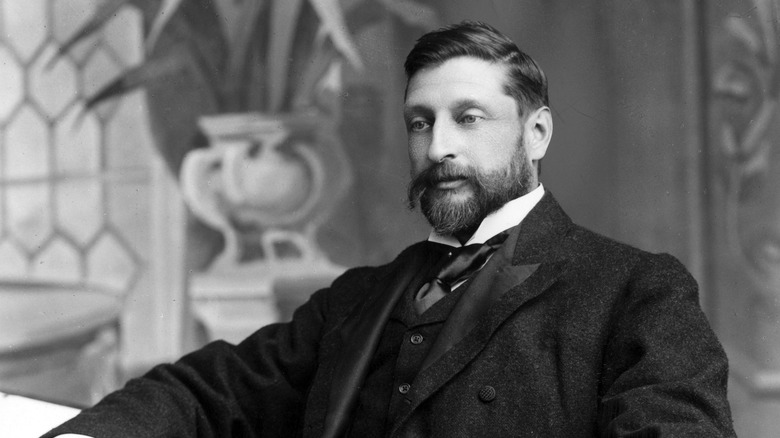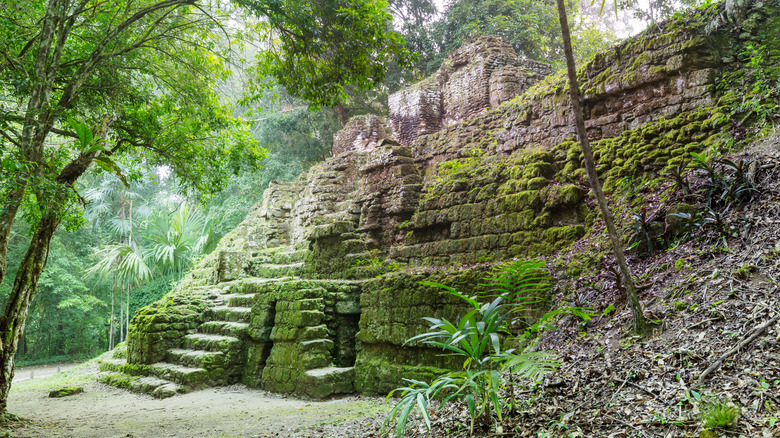The Truth About The Real Life Explorer Who Inspired Indiana Jones
The 1980s franchise "Indiana Jones," which chronicled the life of a fictional professor moonlighting as an explorer, has enthralled audiences for decades on end. The franchise itself spans five full-length films (via Rotten Tomatoes), a television series (via IMDb), books by various authors under multiple different publishers, not to mention a myriad of video games (via Screen Rant) and toy sets. At Walt Disney's theme parks, thrill-seekers can set their sights on Indiana Jones-inspired stunt shows and roller coasters (via Disney World).
This larger-than-life franchise has had such an immense impact on pop culture that it's hard to imagine that one man inspired all these fantastical adventures. Still, there is a real-life Indiana Jones, a man who mapped the Amazon and trekked through dense jungle territory in search of lost cities that perhaps never were (via History). He was a lieutenant, a colonel, a spy, a machete-wielding wilderness man whose obsession with adventure would lead him down a dark and winding path, from which he would vanish from sight forever.
Percy Fawcett, famed explorer that mysteriously vanished
According to History, a man by the name of Percy Fawcett was the inspiration for Indiana Jones. Fawcett was not your typical rogue adventure buff trekking through uncharted territory, relying on instinct or a thirst for fortune. If nothing else, this explorer was every bit a "classic gentleman explorer" trained in the art of espionage under the mentorship of the Royal Geographic Society of London (via History Extra).
Through multiple death-defying expeditions, Percy Fawcett and his crew managed to map out much of the Amazon, which he fondly referred to as "the last great blank space in the world." Fittingly, this great blank space would become the last place he was ever seen alive.
Fawcett's life truly did feature danger at each turn, complete with poison arrows, venomous snakes, swooping bats, and biting piranhas. Some of the authors who penned his story were his personal companions. It was Fawcett's obsession with uncovering a lost world, a sophisticated ancient civilization that he referred to only as Z, that would ultimately lead to his mysterious disappearance. He is still missing today. Theories abound as to what happened to the complex archeological explorer who went on to inspire some of the most riveting stories of our time.
Following multiple successful expeditions, Fawcett was internationally recognized and honored
As an explorer, Percy Fawcett wore many hats, the most famous of which was his Stetson, its broad brim cropping around his introspective features to create that classic Cowboy-meets-rogue-intellectual physique we all now associate with Indiana Jones (via History). Equally impressive were his other hats which included that of mapmaker, British artilleryman, Moroccan spy, amateur archeologist, cultural enthusiast, linguist, explorer, and perhaps most appropriately, legend.
According to the Torbay Civic Society Fawcett made seven expeditions to South America between 1906 and 1924 as he mapped the Amazon forest (per Reuters). And on each trek, he purportedly dug a little deeper into what was either Native territory, the fantastical recesses of his own mind, or some wild combination of the two.
While his exploration might have run off the rails a bit in later years, it appears his journey started off on the ground, quite literally. According to History, the rugged yet refined cartographer was initially implored to make maps of the Amazon for the very reputable Royal Geographical Society. His success in doing so garnered him a gold medal from the institution forging the way for his name to be written on the "Hall of Fame for British Explorers." He shares this accolade with other noted but controversial voyagers of the time, including James Augustus Grant, Sir Ernest Shackleton, and Sir Robert Hermann Schomburgk to name a few.
Fawcett befriended award-winning adventure authors who based their fictional pieces on his life
Before Indiana Jones, there was Allan Quatermain, a 30-something-year-old British character both rugged and refined. According to The Hollywood Reporter, the Quatermain character appeared between the pages of the Sir Henry Rider Haggard series circa 1887 and he featured an uncanny resemblance to the character we all know as Indiana Jones. In fact, Quatermain is recognized by writers and producers as the source of inspiration for Indiana Jones and the action-adventure genre as we know it.
From this perspective, the only way Percy Fawcett could stand as the real-life Indiana Jones is if he were the source of inspiration for the fictional character Allan Quatermain. Shockingly enough, he was! According to The New Yorker, author H. Rider Haggard who penned the series was a treasured friend of Percy Fawcett's and one he held close to his chest. Goodreads describes the fictional Quatermain character as "an imperial outdoorsman" torn between his mission to spread colonialism and his penchant for African cultures and unchartered jungle terrain. This characterization describes Fawcett to a tee.
Another famous writer friend of Fawcett's was Sir Arthur Conan Doyle, who is most known for penning fictional detective Sherlock Holmes (via Britannica). History reports that Doyle introduced readers to Percy Fawcett through the main character in a novel entitled "The Lost World," but there is something to be said for the undeniable similarities between the fictional Holmes and the infamous Percy Fawcett as well.
Fawcett's passion for exploration evolved into an obsession with lost cities
As the title "The Lost World" suggests, Percy Fawcett, both the man and the myth, became obsessed with finding lost cities (per The Telegraph). This fact is easier to understand once we acknowledge that the real-life Indiana Jones was himself, lost, a man seeking some direction he could not find in a compass.
A true aristocrat at birth, Fawcett's father had squandered the family fortune and, in doing so, destroyed the family name (via Time). So, on the streets and in the social circles of London's well-to-do, Percy Fawcett was a walking paradox, a celebrity and an outcast at the same time.
It should be duly noted that he was also a decorated soldier in World War I — but the battlefield was not a true fit for him either. In his heart, he was tormented by the unnecessary bloodshed. The New Yorker reports that even when he walked with native tribes, absorbing and adapting to their fluctuating languages, cultures, and customs, he still was a stranger in many ways, harboring views of the Native Americans that, while more favorable and peace-seeking than his contemporaries, were still wrought with confusion and tainted by the racist colonialism he grew up with.
Only when alone in the jungle did Percy Fawcett find his escape. That escape came in the fantasy of someday unearthing his greatest discovery yet — a lost city of gold.
Perilous search for the Lost City of Z was Fawcett's demise ... or was it?
While Fawcett possessed a passion for all lost cities, there was one in particular that really turned the corners of his iconic swashbuckling hat. He referred to it only as "Z" and, according to History, was convinced it contained an advanced society thriving deep in the Amazon. On expeditions, Fawcett witnessed glimmers of piercing intellect while knee-deep in the jungle and, according to The New Yorker, it was these discoveries that left him thoroughly convinced that Z existed.
He had no shortage of volunteers on this 1925 quest. After all, Fawcett described Z as a city of unfathomable wealth and sophistication (via Mental Floss), and while other voyagers of the time believed the Mato Grasso region of Western Brazil was too menacing to harbor any tribe matching that description, Fawcett disagreed, and he was probably right.
According to Time, one galvanized journalist by the name of David Grann who followed Fawcett's footsteps in an attempt to pen yet another adventure novel, this one entitled "The Lost City of Z," was utterly shocked to learn that there were multiple advanced societies residing precisely in the place Fawcett was looking for them. Archaeologist Michael Heckenberger described one such city, known as Kuikuro Village as possessing "a sense of engineering and mathematics that rivaled anything that was happening in much of Europe at the time." Nearly 100 years later, The question remains — Did Percy Fawcett meet his demise in the jungle or did he find and join a hidden civilization?





